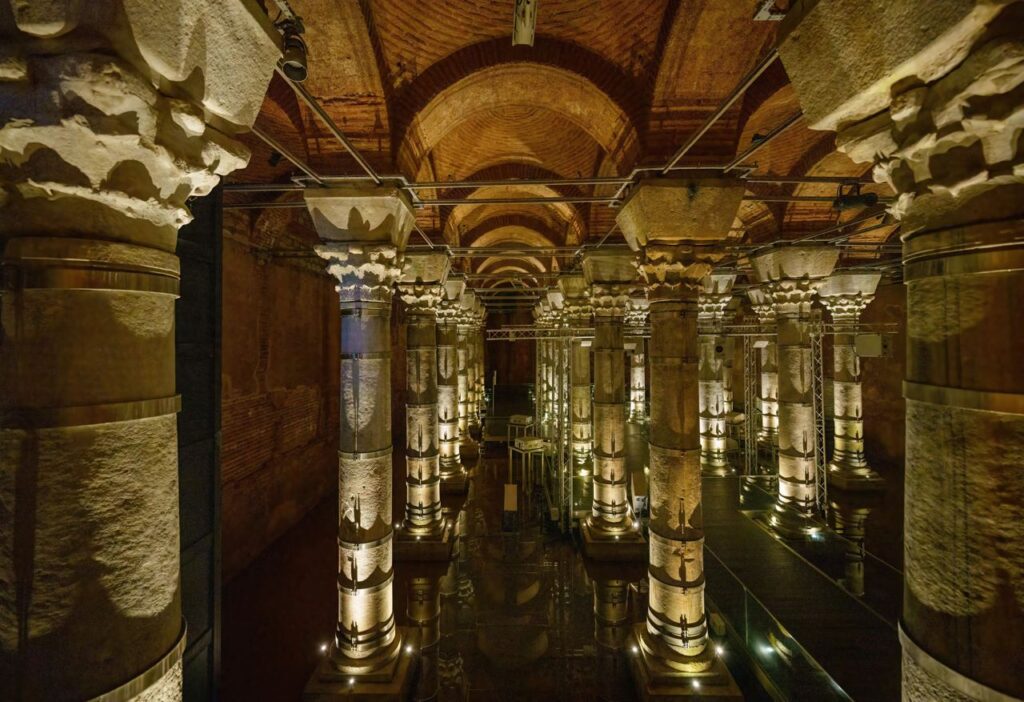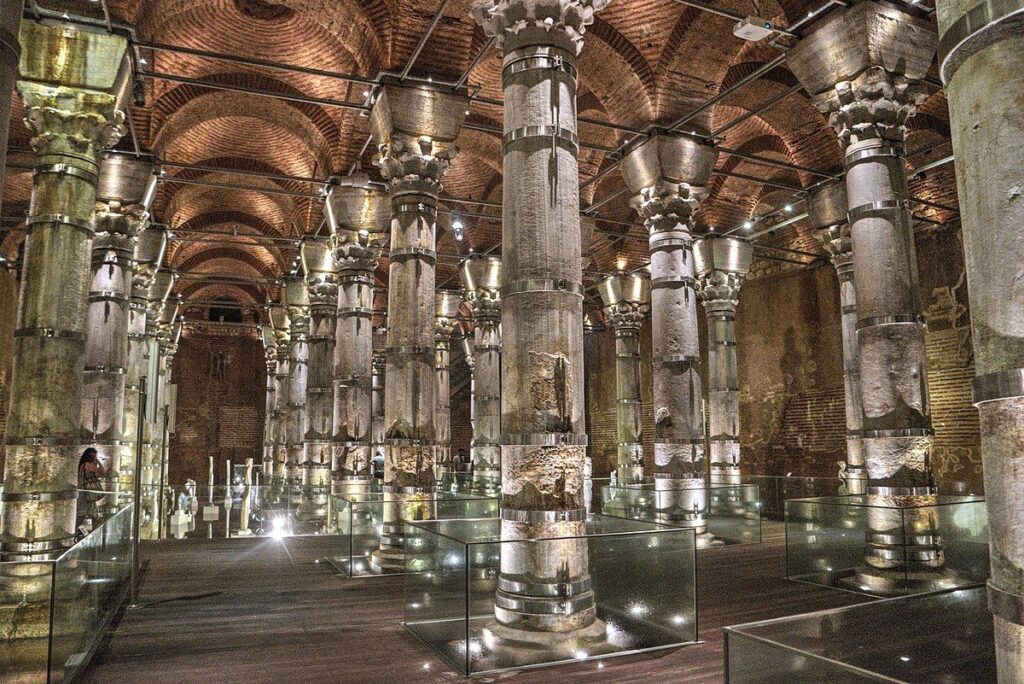Pay Once and Have Free Attractions Entry for 2, 3, 5 or 7 days
Delve deep into Istanbul’s hidden gems as we explore the mysteries of the Theodosius Cistern, one of the city’s magnificent Byzantine relics. Recently restored and open to visitors, this cistern is known locally as the Serefiye Sarnici and boasts a 1500-year history. In this comprehensive guide, we’ll take you through the cistern’s rich history, entrance fees, opening hours, and what to expect when visiting this awe-inspiring subterranean marvel.
The Origins of the Theodosius Cistern
The foundation legend of Istanbul dates back to Ancient Greece. Byzas and his company, departing from the city of Megara near the Gulf of Corinth, established Byzantium on the hill where Topkapi Palace resides today. Initially, the small community had no issue with water shortages, but as Byzantium transformed into Constantinople, the second capital of the Roman Empire, a population explosion led to a significant water crisis.
Read also: Istanbul Underground Attractions: A Journey Beneath the City (2024)

To address this problem, Roman emperors, within a few generations, built the largest water network ever seen. Emperor Valens, for instance, constructed the Valens Aqueduct, which supplied water to Constantinople from Thrace. The water shortage appeared to be resolved, but to sustain the flowing water, tens of cisterns were built in the following centuries, with the Basilica Cistern being the most famous.
Read more about byzantine history and heritage in Istanbul >>
The Construction of the Theodosius Cistern in Istanbul
Although there is no inscription indicating the exact date of construction, architectural characteristics suggest that the Theodosius Cistern was built during the reign of Theodosius II (408-450). Covering a 24m x 40m area with a ceiling up to 11 meters, the cistern features 45 sail vaults and 32 columns. The Corinthian capitals, adorned with acanthus leaves, were made from Marmara Island marble, specially brought for the cistern. The inner walls were covered with watertight plaster, while the corners were curved to ensure pressure resistance. The walls are around 2.5m thick.
Visit the Theodosius Cistern with Guided Tours
What to See in Theodosius Cistern
Impressive Architecture
The Theodosius Cistern features an impressive architectural design, with 45 sail vaults supported by 32 marble columns. Each column is adorned with intricate Corinthian capitals, showcasing the masterful craftsmanship of the Byzantine era. The Marmara Island marble used for the capitals adds a touch of elegance to the cistern.
Ancient Inscriptions
While the Theodosius Cistern does not have its own inscriptions, its architectural characteristics suggest that it was built during the rule of Theodosius II (408-450). As you explore the cistern, try to imagine the ancient workers who constructed this incredible underground water reservoir.

Don’t Miss The Best Tours and Cruises in Istanbul
Visiting the Theodosius Cistern
Location and Accessibility
The Theodosius Cistern is located in the heart of Istanbul’s most touristic district, Sultanahmet. To access the underground cistern, visitors enter a modern-designed glass room and descend a staircase.
Getting to the Theodosius Cistern
- From Old City Hotels: Take the T1 Tram to Cemberlitas station, and then walk for 2 minutes.
- From Taksim Hotels: Take the funicular to Kabatas and get the T1 Tram to Cemberlitas.
- From Sultanahmet Hotels: The museum is within walking distance.
Opening Hours and Entrance Fee of Theodosius Cistern (2024)
The Şerefiye Cistern is open daily from 09:00 to 22:00. Visitors are admitted every hour to experience the mesmerizing light show. To avoid long waits, it’s recommended to arrive around ten minutes before the next show.
The Theodosius Cistern entrance fee is 500 TL.
Enjoy Free Entry to the Theodosius Cistern and Guided Tour with Istanbul E-Pass
The Istanbul E-Pass is a valuable option for travelers, as it offers free entry and guided tours to the Theodosius Cistern, along with 50+ other attractions, providing a convenient and cost-effective way to explore the city.
The Light Show: A 360° Journey Through Time
The Şerefiye Cistern is the first Turkish museum and the oldest building in the world to feature a 360° projection mapping system. This immersive experience takes visitors on a visual journey through the cistern’s 1600-year history, the water culture of Istanbul, and the architectural beauty of the cistern itself.
Cistern Concerts: A Unique Musical Experience
The Theodosius Cistern also hosts periodic concerts, showcasing classical Turkish music, classical Western music, and baroque music. The unparalleled acoustics of this 1600-year-old cistern provide a memorable experience for art and music lovers alike.
Comparing Theodosius Cistern and Basilica Cistern
While the Basilica Cistern is undoubtedly more famous, the Theodosius Cistern has its own unique charm and historical significance. Both cisterns were built to address Constantinople’s water shortages, and they both feature impressive architectural details. However, the Theodosius Cistern offers visitors a more intimate experience, combining art, technology, and history through the 360° projection mapping system and periodic concerts.
More Byzantine Cisterns in Istanbul
In addition to the Theodosius Cistern, Istanbul boasts several other impressive Byzantine cisterns that are worth exploring. These ancient water reservoirs have their own unique features and history, making them essential stops for those interested in delving deeper into the city’s rich past.
Basilica Cistern (Yerebatan Sarnıcı)
The Basilica Cistern, also known as the Yerebatan Sarnıcı, is the largest and most famous cistern in Istanbul. With its forest of 336 marble columns, it is an architectural masterpiece that has captivated visitors for centuries. Read more…
Binbirdirek Cistern (Binbirdirek Sarnıcı)
The Binbirdirek Cistern, also known as the Cistern of 1,001 Columns, is the second-largest cistern in Istanbul. It features 224 marble columns and was once part of the Great Palace complex.
Cistern of Philoxenos (Mocius Cistern, 1001 Direk Sarnıcı)
The Cistern of Philoxenos is a lesser-known cistern that was constructed during the reign of Emperor Justinian. It is also called the Mocius Cistern or the 1001 Columns Cistern, although it only contains 224 columns.
Aetius Cistern (Aetius Sarnıcı)
The Aetius Cistern is another hidden gem of Istanbul, built during the reign of Emperor Justinian I. This cistern has a simple design, featuring 32 columns arranged in four rows.
Aspar Cistern (Aspar Sarnıcı)
The Aspar Cistern is one of the oldest and largest open-air cisterns in Istanbul, built during the reign of Emperor Leo I. Named after the Eastern Roman general Ardabur Aspar, this cistern once supplied water to the Great Palace and the Hippodrome.
Conclusion
The Theodosius Cistern is a must-visit destination for anyone interested in Istanbul’s rich history and architectural heritage. This subterranean marvel has been meticulously restored and features impressive architectural details and a mesmerizing light show that takes visitors on a journey through time. With periodic concerts and well-preserved historical artifacts, the Theodosius Cistern offers a unique experience that is sure to captivate visitors of all ages. So, if you’re planning a trip to Istanbul, be sure to add this hidden gem to your itinerary!
Visitor Information
-
💵
Entrance Fee: 500 TL
-
⌛Opening Hours: from 09:00 to 22:00
-
⛔
Closed: No
-
📍
Location: Binbirdirek, Piyer Loti Cd. No:2/1, 34122 Fatih/İstanbul
FAQs
Q: How many cisterns were in Constantinople?
A: Tens of cisterns were built in Constantinople over the centuries to address the city’s water shortages. Some of the most famous ones include the Basilica Cistern and the Theodosius Cistern.
Q: What is a cistern?
A: A cistern is an underground chamber designed to store and hold water, often built in areas with limited water resources or to ensure a water supply during sieges.
Q: Is the Theodosius Cistern worth visiting compared to the more famous Basilica Cistern?
A: Yes, the Theodosius Cistern offers a unique experience with its 360° projection mapping system, periodic concerts, and well-preserved architectural details. It’s an excellent option for those interested in exploring lesser-known historical sites in Istanbul.
Q: Can I take photos inside the Theodosius Cistern?
A: Yes, visitors are allowed to take photos inside the cistern, capturing its stunning architecture and mesmerizing light show.
Q: Are there guided tours available for the Theodosius Cistern?
A: Although there is no official information inside the cistern about guided tours, visitors can use this article as a guide or book a private tour to gain a deeper understanding of the cistern’s history and significance.
You Might Be Interested in
- Best Food Delivery Apps in Istanbul: How to Order Food In
- Istanbul in May: Weather & Things to Do, Events in 2024
- April Weather in Istanbul: The Ultimate Guide for Travelers (2024)
- How to Make Turkish Coffee: Step-by-Step Recipe
- Explore Maltepe in Istanbul (Asian Side): Things to Do & See, Hotels, Restaurants (2024)
- Traveling in Istanbul with a Baby: Places to See and Tips for a Pleasant Vacation
- Istanbul Ruines and Constantinopol Sites: A Journey Through Byzantine History
- Galata Tower in Istanbul: Entrance Fee, Opening Hours, History & What to See (2024)
- Istanbul Archaeological Museums: Museums, Tickets, Opening Hours (2024)
- 8 Best Taksim Square Hotels in Istanbul from Luxury to Budget (2024)
Don’t Miss The Best Tours and Cruises in Istanbul